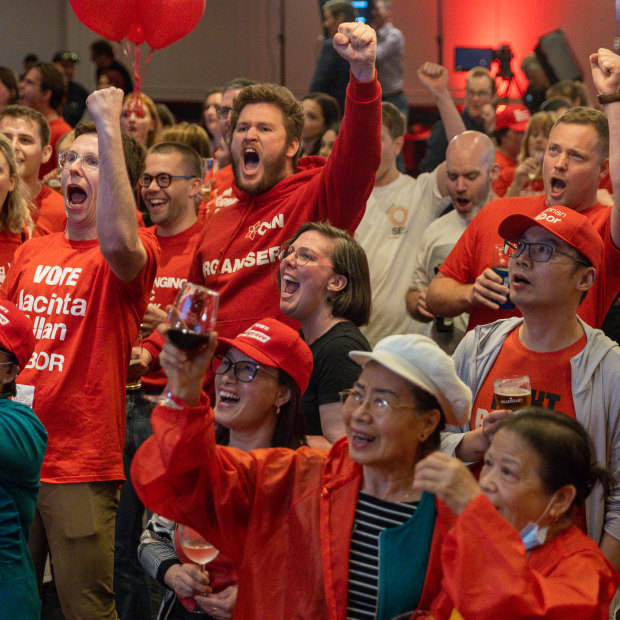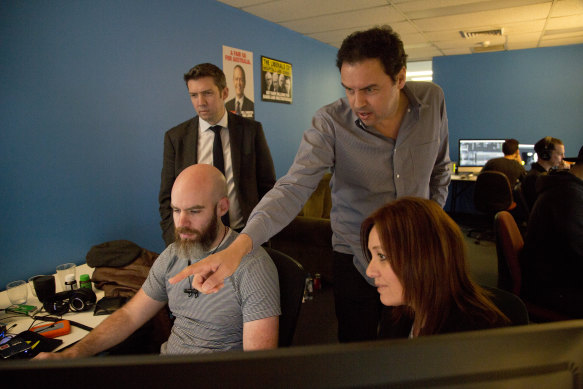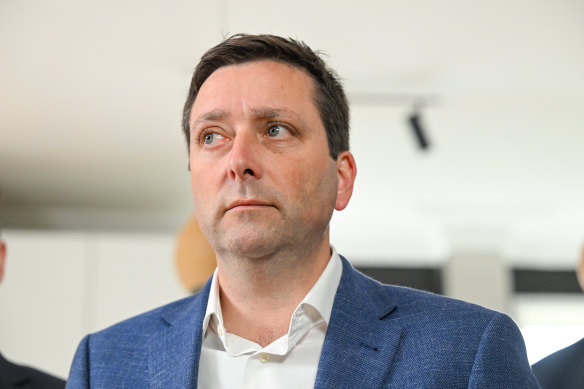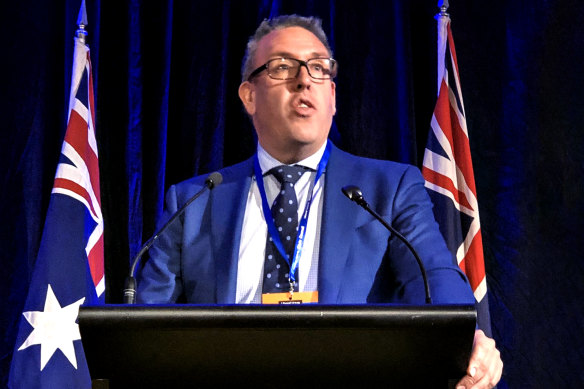This was published 2 years ago
How Labor pulled off the sweetest victory of all
By Sumeyya Ilanbey and Royce Millar

Labor Party supporters cheer after the ABC projects an ALP win on Saturday night.Credit: Getty Images
There were times during the state election campaign when even Daniel Andrews had his doubts that Labor would win the majority necessary to form government for a third consecutive term in Victoria.
After eight years in office and three years he describes as “the hardest times anyone can remember”, the ever-dominant Premier was unsure. He says anyone in politics who has been at the centre of a hard-fought election and claims otherwise “is not telling you the truth”.
“Campaigns are always gruelling,” he tells The Age in an exclusive post-poll interview. “And, by definition, you’re in a bit of a bubble.”
But Andrews need not have worried. Labor has been returned with a majority just short of its 2018 “Danslide” victory, and looks set to have an upper house more friendly and supportive of progressive legislation than in the last term.
This despite a pandemic, the “use-by” factor of an ageing government and an opposition campaign that sought a referendum on Andrews.
So how did Labor pull off the sweetest victory of all?
The Labor machine
Part of the answer lay in Labor’s campaign machine, widely acknowledged across politics as vastly superior to that of the opposition.
As late as election day, ALP state secretary Chris Ford told nervous Labor faithful to hope for the best but prepare for the worst; that he expected Labor to win between 43 and 46 seats; and that the line between minority and majority government was razor-thin.
But within three hours of polls closing, ABC election guru Antony Green declared Labor would be returned with more than 50 seats and just after 10.30pm, dejected Liberal leader Matthew Guy called Andrews to concede.
Ford had taken the reins of Victorian Labor amid the media revelations and official investigation of industrial-scale branch stacking by former frontbencher Adem Somyurek. For Ford it was an especially sweet victory after one of the state’s most bitter and divisive campaigns.
The internal recriminations over branch stacking were intense, but there was an election to win against the backdrop of a pandemic and loud agitators who spewed violence. Labor insiders describe Ford as a shrewd strategist who surrounded himself with a ruthlessly professional campaign machine.
Labor’s fight for the 2022 election began in September 2020, at the height of Victoria’s second lockdown, when Ford commissioned focus groups to gauge the mood of Victorians and called on Labor advertising guru Darren Moss, from Moss Group, to sit in on those meetings.
Moss had helped rebrand Andrews in 2014, transforming him from Dorky Daniel to Dapper Dan on his path to consigning the Liberals to a single-term government. He was also integral to Victorian Labor’s 2018 victory.
There were three groups of people Labor identified as targets in those early days: men who worked in blue-collar industries; women who worked in retail, healthcare and other lower-paid jobs; and multicultural communities.

Darren Moss (pointing) while working on Bill Shorten’s campaign in 2019. He was brought in to work on the Andrews campaign.Credit: Ryan Stuart
During the pandemic, the first group were seen as the most likely to shift their vote from Labor to Liberal, and the richer they were, the less likely they were to move back into the red column. Women were more likely to stick with Labor, but the party was concerned they would be the next to desert the government.
Labor spent 18 months speaking to people in focus groups. But the seriously intense period began after the federal election in May, when Ford, Moss, Labor’s assistant secretaries, Cameron Petrie and Nicola Castleman, and veteran campaign strategist John Utting sat in on the groups and followed meetings every night for months.
By the end, they were confident they understood the mood of Victorians.
The Dan factor
Then there is Andrews, one of Australia’s most dominant political figures of the modern era.
His reputation had been tarnished during the pandemic and multiple integrity scandals had engulfed the government; the healthcare system was under pressure.
Views differ, both within Labor and beyond, about how important Andrews was in Labor’s success last week. But no one doubts his strength as a leader, his record of getting stuff done, his capacity for work, his communication skills and the extent of his political nous.
Utting, for one, describes him as the “the single biggest factor because of the high quality of his leadership”.
Andrews and the Labor team knew there was no point glossing over the perceptions; Andrews could not be hidden. That would only open Labor to accusations it was running scared, and give their opponents ammunition.
Both the party and Andrews believed that voters just needed to be reminded of what Labor had done in infrastructure in particular, and of the bold can-do reputation that underpinned the Danslide result in 2018.
Guy factor
Then there was Labor’s key weapon – the opposition. According to Labor focus groups, Victorians just never warmed to Guy, recycled as party leader after taking the Liberals to their disastrous 2018 defeat.
Utting says that part of Labor’s strategy was to “remind” people why they didn’t vote for Guy in 2018.

Victorians just never warmed to Matthew Guy.Credit: Joe Armao
The party’s national secretary, Paul Erickson, says the state branch worked to associate Andrews with eight years of delivering, and not two years of COVID-19.
“They wanted to make the argument that if Matthew Guy and the Liberals were elected, all of that progress would be lost,” he says.
Rather than allowing the election to be a referendum on Andrews and his handling of the pandemic, Labor’s strategy was to make it a choice between Andrews and Guy and – as one Labor strategist puts it – to make Guy “unelectable” by depicting him as the “cuts guy” and a weak leader who supported MPs Tim Smith and David Davis amid controversies around drink-driving and alleged drunken, inappropriate comments.
The Liberals were also facing an existential crisis as they struggled to ward off teal independents and hold the votes of traditional well-to-do moderates in seats like Malvern and Kew, as well as appealing to more right-leaning, often religious voters who now dominate some outer-suburban and regional branches of the party.
Some Liberal candidates and MPs are furious at what they say was a shambolic campaign run by a disorganised, unprofessional party head office. The state director, Sam McQuestin, and Guy were not getting along. There was no coherent strategy or message. Liberal strategists seemingly ignored polling and research from 18 months ago that the party should direct its resources at the outer western and northern suburbs.
Labor frontbencher and Western Region upper house MP Jaala Pulford says the Liberals were her party’s single strongest weapon. “They have turned themselves into a weirdo fringe outfit,” she says. “They lack fundamental competence, and they’ve just become very wacky.”

State Liberal director Sam McQuestin has quit after the party’s election defeat.
ALP hardheads had charted a clear path to a solid – if not perfect – campaign. They just needed to stick to their guns.
“The election result reflects the professionalism and strength of the Victorian Labor Party and the broader Labor movement,” Ford says.
“It is clear that the quality of people working and volunteering on this campaign – both at a local level and at campaign headquarters – was of an exceptionally high standard and miles ahead of our competitors.”
Around July, at the height of Victoria’s triple-zero crisis, Ford and the Labor team were working out what Labor’s slogan would be. They workshopped a few ideas, but none really stuck.
Ford spoke to a stranger who knew he was Labor state secretary and wished him good luck for the campaign. Ford confided he would need it. The man responded, incredulously: “Nah, surely not, Andrews is just doing stuff.”
It was a Eureka moment for Ford and his team that gave the campaign its slogan: Doing what matters. It was a humble offering to remind Victorians about what Labor had delivered and promise Victorians that it would continue to deliver. Unlike the Liberal Party, which was focusing on the past and urging Victorians to punish Andrews over his government’s mistakes, the Labor Party was laying out a vision for the future.
Around the same time, Moss got cracking on two ads that Labor pummelled voters with for five weeks in the lead-up to election day: “the cuts Guy” and “the wrong Guy”.
Labor’s “positive” ads reinforced their central theme that the Andrews government had removed level crossings, saved TAFE and built hospitals, before offering a future-focused message about hiring more nurses and driving down power bills.
Having worked as assistant state secretary in the late ’90s, Andrews knew what it took to run a good campaign and win. His colleagues have routinely criticised him for arrogance and an inability to work in a collegiate way; but Ford and others say the Labor leader was tireless and disciplined during the campaign.
Andrews says his experience at party HQ has helped. “I’m blessed in that. I’ve done both these jobs ... I know how campaigns work.”
In August, Labor also engaged media-buying agency Mindshare Melbourne, which ran an unprecedented media buying campaign. It was laying the groundwork for the technology and infrastructure to sell Labor’s message, while simultaneously crafting its campaign, backed up by research that the party spent record amounts on.
For five weeks in the lead-up to election day, Victorian Labor pumped out the same five ads, whereas the Liberal Party chopped and changed what it dished out to viewers.
Where Labor had real people walking with Andrews, the Liberals had Guy standing in front of a green screen, badly put-together ads of Victorians lamenting the Andrews government, and a slogan that changed from “Put Labor last” to “vote Liberal”.
Labor also spent a record amount on its advertising, the vast bulk of it in the final days, even though half of Victorians had already voted. It looked like a risky strategy, but the party knew those voters who were most likely to decide the outcome voted on election day.
Andrews stresses that a key difference between the Labor and Liberal campaigns is the extent of grassroots volunteering, including door-knocking and phone-calling by Labor members, supporters and especially trade union members, such as nurses.
“We’ve enjoyed some success,” says Andrews, “because our movement is a movement, and it starts from the ground.
“It’s not confected. You know, we’re not paying people to do it. When a nurse gets on the phone and says ‘I’m voting Labor. And here are the reasons why’, that helps people discover why they should vote Labor too.”
Demographics
It’s easy to put Labor’s election win down to the campaign machine or the leader, but underlying political trends in the community are also crucial.
At state and federal levels, the primary vote of both major parties is in decline.
Labor faces its own challenges in its western and northern suburban heartlands, where battlers seem increasingly alienated from the traditional “workers’ party”, a trend accentuated by the region being disproportionately affected by the pandemic.
But the party’s buffer is so substantial in some seats that it could absorb big swings this election. While Labor and its leader ran strong campaigns, Victoria’s political leanings have skewed left over the past 30 years, effectively blocking the Coalition from winning government.
A wider countervailing trend is that of young voters – millennials and Generation Z – away from the Liberals to either Labor or other progressive parties or candidates, including the Greens, Socialists and teals.
This election about 40 per cent of the under-35 vote went to Labor. Liberals struggled to get 10 per cent. The Greens and the increasingly organised Socialists picked up the bulk of the rest.
That trend allows Labor to survive the decline in its primary vote, because the wider left vote comes back to it in preferences.
Former Labor strategist and Redbridge pollster Kos Samaras says that, unlike previous generations, today’s younger voters – many priced out of the residential property market – are not becoming more conservative as they age.
“That’s because they’re both progressive and disenfranchised,” says Samaras. “They’re an educated but financially disenfranchised cohort. And they’re taking their politics with them as they age.”
Still, with Labor facing challenges from right-leaning parties and independents in once safe seats in the outer west and north and from the left in the old inner-city heartland, the celebrations from the 2022 election will be short-lived.
Not everything went right for the Labor campaign. Often communication with some local candidates was not clear or consistent; despite suffering massive swings in traditional heartland seats in the federal election, Labor did not do any real work during the state campaign to target Melbourne’s west, north and south-east.
There’s a salient lesson for the Labor Party to maintain a laser-like focus on improving services and lifting the living standards of working-class people in the suburbs and regions. While the Liberal Party will look at how it will connect with Victorians, Labor will sharpen its focus on how to reconnect with its base.
Less than 12 hours after his victory speech, Andrews held a press conference in the lush gardens of the Victorian Parliament. Beaming, he could finally let a sigh of relief and release the tension in his body. He was asked about the swings against the Labor Party in heartland seats.
He thanked Victorians who voted for him, and promised to govern for everyone, including those who hadn’t.
“There’s some work to do in those communities,” Andrews confessed. “And I will do that very important work. This has been quite an unprecedented time in our state’s history, and different families, different people, different communities have experienced this in different ways. We have to be alive to that and we have to respect that, and I absolutely respect and acknowledge that this has not been a very uniform experience. It has been very challenging.”
The Morning Edition newsletter is our guide to the day’s most important and interesting stories, analysis and insights. Sign up here.